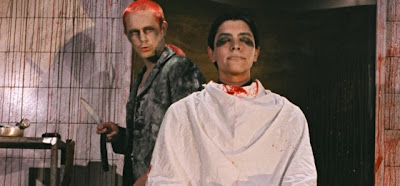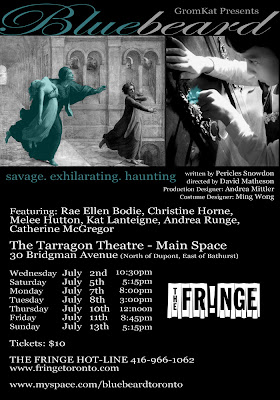American monologuist and regional theatre reform advocate Mike Daisey has thrown down a blistering response to Theatre Communications Group executive director Teresa Eyring’s How Theatre Saved America, which was published in the current issue of American Theatre.
Eyring argues that the current repertory model in the U.S. is in fine working order:
“Many actors – instead of performing in several shows with a single theatre company in the same season – construct year-round employment by performing in different theatres throughout the year.”
Daisey disagrees:
“If actors manage to create community and continuity IN SPITE OF the institutions, no credit for that reflects back on theaters that refuse to support artists in a meaningful fashion: with staff positions, with health insurance, with a modicum of respect and dignity earned by working craftsman anywhere. Dribs and drabs of roles given when artists can jump for them are no substitute for real institutional support, and to claim otherwise is absurd.”
Daisey ends with a challenge to the magazine to devote an entire issue to the concerns raised in his hit monologue, How Theatre Failed America, opening its pages to “informed bloggers and theatrical luminaries.”
University of North Carolina drama professor and oft-quoted theatre blogger Scott Walters agrees enthusiastically with the suggestion, here.
What do you think? Are theatre’s regional institutions looking out for the artists? Or are they simply working to preserve their own outdated apparatus?
 By Michael Wheeler
By Michael Wheeler
Question:
You have a $10,000 a year budget for transportation.
You:
A) Rent a Lamborghini Countache for ten days, and drive it around like hell. Walk everywhere the other 50.5 weeks of the year.
B) Get a sensible sedan on a 12-month lease.
C) Alternate between a transit pass and bicycle. Use the savings to do something interesting.
This was my response to a co-worker who had seen BlackWatch the previous evening. He told me that although they had initially agreed with my earlier Lumi-not-go post, after seeing the production he had come to a different conclusion about the value of the festival. Anything that brings something that good to Toronto must be a good thing.
I really like Lamborghini Countaches too. A long time ago I had a poster of one above my bed. But option A is clearly ludicrous. It’s the same reason why spending $21.5 million over three years on an international festival that bring some of the best artistic work in the world to the T Dot for a short, extremely well publicized run, is also a very poor, frankly ignorant, decision.
Theatre at every level but the best of the most established institutions is in bad shape in this city right now. There’s a myriad of reasons for this best saved for another conversation, but the short version is as follows:
Mike Daisey is right and it’s the same situation up here. Being a theatre artist has ceased to become a profession you can make anything approaching a respectable living at in Toronto for all but handful of our very top practitioners. These lucky folks are still often working 12-hour days and six-day weeks for much less than what any of our non-thesbian friends make. Many of them probably do a little catering on the side to make ends meet. The earth is scorched. Anyone who puts economic well-being in their top-ten list of personal priorities would not come within a stone’s throw of this scene.
Yes, the theatre has always been in trouble. Yes, making art is hard. But the current theatrical economy is a graveyard for anyone who may have to pay bills, rent or student loans. We can see this in what has become of our grassroots institutions, places where the new generation of artists rehearse and perform:
Artword Theatre – gone.
Alchemy Theatre – gone.
Poor Alex Theatre – gone.
Equity Showcase Theatre – going, soon to be gone.
Not only are there few resources to create work, there is no longer anywhere affordable to put shows on.
In the wake of this grim reality, a couple of corporate head honchos who seem entirely unaware of any of this, waltzing in and deciding that they know best with what to do with the first increase in public money that’s been available to the performing arts in some time is a recipe for disaster. Lavishing much of those resources on smash hit shows from other places – a fellow indie theatre producer described it to me as, “putting makeup on a corpse.”
 The Scottish Youth Theatre preps a new generation of performers.
The Scottish Youth Theatre preps a new generation of performers.Of course BlackWatch was amazing. Not only is Scotland, at roughly the size of New Brunswick home to the world’s premiere Fringe Festival, it has 300 youth theatres. Just for youth. The very best end up at the national chapter, The Scottish Youth Theatre. Many in the BlackWatch cast went through that system. The show represents the tip of a very large iceberg. The country has invested heavily in value of theatre and it is paying dividends – literally. It gets to tour to high-paying international festivals that rent the tips of other peoples icebergs because they don’t want the trouble of building their own.
My original idea for this piece was to throw out a number of options as to how this money could be used in different scenarios. Instead I settled on the 2007 Toronto Arts Council 2007 numbers because similar to Luminato, the TAC funds: Community Arts, Dance, Music, Literature and Theatre in Toronto. It’s a fair comparison. Well, not entirely fair. One does 10 days of programming and one does 365.
In 2007, The Toronto Arts Council distributed $9,738,829 – $247, 725 of which was for theatre project grants (which incidentally is the approximate value of one Lamborghini Countach) to be divided amongst 51 successful applicants. An even more interesting number is: $2,152,783. This is the total amount in project grants in all disciplines that were distributed, when you take out grants for operating funds and to large institutions.
What does it mean when you compare this to Luminato’s $21.5 Million over three years?
A) If we gave Luminato’s money to the TAC we could increase the TAC budget by more than 66%. This is a pedestrian statistic, but the impact of this would be massive.
B) You could more than double the amount of successful project grant applicants and double the amount each project receives.*
*$2,152,783 in project grants + 1 year of Luminato’s $21.5 million = $9,319,449.70
Twice as many project grants =$ 4,305,566 x 2 to double the grants = $8,611,132.00
Twice as many projects with twice as much municipal funding.
It would permanently change how art was created in this town. How much more, better work would go on year-round? How many artists would be able to stop working as waiters and temps and actually practice their craft for at least a couple of months? How many audience members and patrons could we get excited about this thing again by actually having the cash to create this massive wave of new, plausibly funded projects? How many of them could potentially turn in to the next BlackWatch?
Take Unspun Theatre’s production of Minotaur: It was one of my favorite shows of the year. It was new, exciting, smart; full of young artists taking big risks. Well received, well reviewed. I really think they ought to take it on tour. The production received a total of $14,000 in public funding (through OAC and Canada Council). With Luminato’s $21.5 million money you could create 1,500 Minotaurs.
 In any case, our government opted instead to give it to their friends for a ten-day play date. They’re likely at their cottages in Muskoka right now talking about how lovely the whole thing was with the glowing balls in Dundas Square (which is usually so dirty) and chuckling about how many times they heard the c-word in Blackwatch. Meanwhile we sit here in the heat wondering how we’ll ever make his thing work again. The opportunity was there, it’s gone, it sucks.
In any case, our government opted instead to give it to their friends for a ten-day play date. They’re likely at their cottages in Muskoka right now talking about how lovely the whole thing was with the glowing balls in Dundas Square (which is usually so dirty) and chuckling about how many times they heard the c-word in Blackwatch. Meanwhile we sit here in the heat wondering how we’ll ever make his thing work again. The opportunity was there, it’s gone, it sucks.
An Olive Branch:
Alright Luminato, I promise to stop hating on you, and all you have to do is one thing:
Return the interest you’re going to make on keeping our extra $15 million in the bank “for the future” back to Toronto’s artists. We’re frigging starving down here, and it’s breadcrumbs really, but we’ll take it. If we trust the math put forth by an anonymous commenter on my original post, that would be $450,000 a year. It would really help. It’s almost double what was distributed for theatre projects last year by the TAC. That’s two Lamborghini Countaches for those of you playing along at home.
Correction. My original Lumi-not-go post incorrectly stated Luminato CEO Janice Price was American. This is not true. Although she comes to us from The Kimmel Centre in Philadelphia, The Lincoln Centre in New York and is a previous vice president of The Shakespeare Association of America, she is in fact a Canadian. My bad.
This is the fourth and final in a series of four blog posts on theatre by Praxis Theatre Co-Artistic Director Michael Wheeler.
 My First Headshot (1999).
My First Headshot (1999).By Michael Wheeler
A strange thing happened to me this year: I ended up splitting with my fancypants agent and doing more acting than I’d done in the four previous years with representation. It wasn’t something I’d planned. It just kinda developed, and it has me thinking all sorts of things about how and what I want to do in the theatre.
A year and a half ago I had seriously considered hanging up my acting shoes. Being Co-Artistic Director of an indie company and directing shows around town was fulfilling and taking up a huge amount of time. Running around to audition to be an SOC hockey fan in an insurance commercial, or talking broccoli (aka a principal role) in a Sobey’s spot seemed to be a distraction for the most part. I had been given some friendly advice from several quarters that “you can’t be all things to all people” and that if I really wanted to make a name for myself as a director, I should firmly establish myself exclusively as one.
This also made sense to me because acting wasn’t too much fun anymore. When I finished my acting MFA in The States I did the mandatory 1 year in NYC that your visa allows for. I turned into a serious stress case of an actor with essentially 10 months to become wildly successful in order to extend my stay. I started with a part in a show at The Ontological Theatre and spun that into a mediocre agent who also doubled as a radio commentator for the New York Giants. I hustled like crazy between open calls, what the agent could find me, and up to 5 different joe jobs, but much to my dismay I did not find myself wildly successful.
This was partially because the odds of this working out for me were pretty low, but also because of how I was performing and auditioning. The whole I must define my career with this performance attitude the situation had me left me too tense and probably in hindsight, desperate, to really do anything like that. I returned to Toronto just in time for SARS, signing on as the first male client of a failure of a startup agency before landing an agent who was decidedly blue-chip a year later.
The pitiful state of the industry and being the smallest name on a big time roster meant opportunities to audition for projects that weren’t advertising came on a bi-monthly basis. Six, five-minute opportunities a year, to establish myself. It wasn’t cool. I kept myself in classes, volunteered to read for casting directors, but nothing seemed to give. The experience contrasted heavily with the success we were having with Praxis and the whole being an actor for hire thing started to feel like a raw deal. Eventually the agent and I mutually agreed that we “were not a good match”.
 Fort at York workshop #1.
Fort at York workshop #1.So I kind of surprised myself when I showed up to audition for The Fort At York. Over the course of two publicly presented workshops, I played first a mute kitchen boy named with a tendency to break into monologue, and eventually a soldier named Everett with some serious psychological problems in the final production. This led directly to playing an anarchist artist in Save Us at HATCH this year, I followed it immediately by acting in a Praxis Theatre show for the first time as The Prosecutor in our workshop presentation of Stranger.
And all of a sudden acting was a) fun again and b) I was much better at it. The major reason for this was simple: I no longer felt this overwhelming compulsion to make my career with a single performance. My breathing was controlled, shoulders went back, I found stillness, and had confidence in my ability to entertain without striving to entertain. All the little things I understood from my training intellectually, but hadn’t been able to incorporate practically with regularity. It’s tough to breathe from support and have crisp final consonants when you’re trying desperately to succeed like no one has ever succeeded before.
 Save Us reading at Cameron House.
Save Us reading at Cameron House.I am grateful to Tara Beagan, Chris Reynolds, Chad Dembski and Simon Rice for creating three shows that really fostered an exchange of ideas and valued collaboration in rehearsal. I had a lot of confidence in these projects because I was afforded the opportunity to play a part in things from the get-go. I also remembered something I forgot: I love opening night. As a kid I had hoped first to play for The Toronto Blue Jays and later, as a starter on any NBA team but The Utah Jazz. It was only after both of these goals proved entirely unrealistic that I started to get heavily into theatre at 16. In hindsight, I think I know why now:
Opening night as a performer, and all the shows that follow, is the closest you can get to approximating Game Day in sports. There is a specific time where you have to show up in front of a crowd of people. You get one chance to do something special with your teammates. The nerves, the excitement, the onus on yourself to thrive under pressure – once I lost an impossible sense of tension and just concentrated on the task at hand – it became addictive again. If I’m not going to play in the NBA Finals, this is as good as it’s going to get. And it’s pretty good.
So Mike the actor is back – resurrected from the graveyard of classic frustrations that plague actors in their first years out of a training program. Screw pigeonholing myself. Theatre pays so poorly we ought to do exactly the types of projects we would like to do and often you have to find these things yourself. And maybe a new agent.
This is the third in a series of four blog posts on theatre by Praxis Theatre Co-Artistic Director Michael Wheeler.













Recent Comments